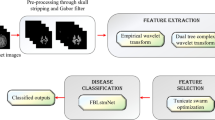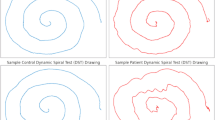Abstract
Parkinson’s disease (PD) is a chronic and progressive neurological illness affecting millions of people in the world. The cure for PD is not available. Drug therapies can handle some symptoms of disease like reducing tremor. PD is diagnosed with decrease in dopamine concentrations in the brain by using clinical tests. Early detection of the disease is important for the treatment. In this study, dynamic spiral test (DST) and static spiral test (SST) of PD patients were analyzed with pre-trained deep learning algorithms for early detection of PD. Fuzzy recurrence plot (FRP) technique was used to convert time-series signals to grayscale texture images. Several time-series signals were tested to observe the performances. The deep learning algorithms were employed as classifiers and feature extractors. Drawing and signal types’ performances for classifying PD were comprehensively investigated. In short, according to the experimental results Y signal produced the best results in DST approach and arithmetic combination of the Y and P signals performed better in SST method.







Similar content being viewed by others
References
Singh N, Pillay V, Choonara YE (2007) Advances in the treatment of Parkinson’s disease. Prog Neurobiol 81(1):29–44. https://doi.org/10.1016/j.pneurobio.2006.11.009
Dorsey E, Constantinescu R, Thompson J, Biglan K, Holloway R, Kieburtz K, Marshall F, Ravina B, Schifitto G, Siderowf A (2007) Projected number of people with Parkinson disease in the most populous nations, 2005 through 2030. Neurology 68(5):384–386
Jankovic J (2008) Parkinson’s disease: clinical features and diagnosis. J Neurol Neurosurg Psychiatry 79(4):368–376. https://doi.org/10.1136/jnnp.2007.131045
Tolosa E, Wenning G, Poewe W (2006) The diagnosis of Parkinson’s disease. Lancet Neurol 5(1):75–86
Robbins JA, Logemann JA, Kirshner HS (1986) Swallowing and speech production in Parkinson’s disease. Ann Neurol 19(3):283–287
Sakar BE, Isenkul ME, Sakar CO, Sertbas A, Gurgen F, Delil S, Apaydin H, Kursun O (2013) Collection and analysis of a Parkinson speech dataset with multiple types of sound recordings. IEEE J Biomedi Health Inf 17(4):828–834
Cantürk İ, Karabiber F (2016) A machine learning system for the diagnosis of Parkinson’s disease from speech signals and its application to multiple speech signal types. Arab J Sci Eng 41(12):5049–5059. https://doi.org/10.1007/s13369-016-2206-3
Tsanas A, Little MA, McSharry PE, Spielman J, Ramig LO (2012) Novel speech signal processing algorithms for high-accuracy classification of Parkinson’s disease. IEEE Trans Biomed Eng 59(5):1264–1271
Sharma P, Sundaram S, Sharma M, Sharma A, Gupta D (2019) Diagnosis of Parkinson’s disease using modified grey wolf optimization. Cognit Syst Res 54:100–115
Almeida JS, Rebouças Filho PP, Carneiro T, Wei W, Damaševičius R, Maskeliūnas R, de Albuquerque VHC (2019) Detecting Parkinson’s disease with sustained phonation and speech signals using machine learning techniques. Pattern Recognit Lett 125:55–62
Braga D, Madureira AM, Coelho L, Ajith R (2019) Automatic detection of Parkinson’s disease based on acoustic analysis of speech. Eng Appl Artif Intell 77:148–158
Mostafa SA, Mustapha A, Mohammed MA, Hamed RI, Arunkumar N, Ghani MKA, Jaber MM, Khaleefah SH (2019) Examining multiple feature evaluation and classification methods for improving the diagnosis of Parkinson’s disease. Cognit Syst Res 54:90–99
Kaur S, Aggarwal H, Rani R (2019) Diagnosis of Parkinson’s disease using principle component analysis and deep learning. J Med Imaging Health Inf 9(3):602–609
Rosenblum S, Samuel M, Zlotnik S, Erikh I, Schlesinger I (2013) Handwriting as an objective tool for Parkinson’s disease diagnosis. J Neurol 260(9):2357–2361
Kotsavasiloglou C, Kostikis N, Hristu-Varsakelis D, Arnaoutoglou M (2017) Machine learning-based classification of simple drawing movements in Parkinson’s disease. Biomed Signal Process Control 31:174–180
Pereira CR, Weber SA, Hook C, Rosa GH, Papa JP (2016)Deep learning-aided Parkinson’s disease diagnosis from handwritten dynamics. In: 2016 29th SIBGRAPI conference on graphics, patterns and images (SIBGRAPI). IEEE, pp 340–346
Pereira CR, Pereira DR, Rosa GH, Albuquerque VH, Weber SA, Hook C, Papa JP (2018) Handwritten dynamics assessment through convolutional neural networks: an application to Parkinson’s disease identification. Artif Intell Med 87:67–77
Rios-Urrego CD, Vásquez-Correa JC, Vargas-Bonilla JF, Nöth E, Lopera F, Orozco-Arroyave JR (2019) Analysis and evaluation of handwriting in patients with Parkinson’s disease using kinematic, geometrical, and non-linear features. Comput Methods Progr Biomed 173:43–52
Naseer A, Rani M, Naz S, Razzak MI, Imran M, Xu G (2020) Refining Parkinson’s neurological disorder identification through deep transfer learning. Neural Comput Appl 32(3):839–854
Impedovo D, Pirlo G (2018) Dynamic handwriting analysis for the assessment of neurodegenerative diseases: a pattern recognition perspective. IEEE Rev Biomed Eng 12:209–220
Zham P, Kumar DK, Dabnichki P, Poosapadi Arjunan S, Raghav S (2017) Distinguishing different stages of Parkinson’s disease using composite index of speed and pen-pressure of sketching a spiral. Front Neurol 8:435
Sahyoun A, Chehab K, Al-Madani O, Aloul F, Sagahyroon A (2016) ParkNosis: Diagnosing Parkinson’s disease using mobile phones. In: 2016 IEEE 18th international conference on e-health networking, applications and services (Healthcom). IEEE, pp 1–6
Ribeiro LC, Afonso LC, Papa JP (2019) Bag of samplings for computer-assisted Parkinson’s disease diagnosis based on recurrent neural networks. Comput Biol Med 115:103477
Pham T (2017) Fuzzy recurrence plots. EPL Europhys Lett 116(5):50008
Eckmann J, Kamphorst SO, Ruelle D (1995) Recurrence plots of dynamical systems. World Sci Ser Nonlinear Sci Ser A 16:441–446
Isenkul M, Sakar B, Kursun O (2014) Improved spiral test using digitized graphics tablet for monitoring Parkinson’s disease. In: Proceedings of the international conference on electronic -health and telemedicine, pp 171–175
Marwan N, Romano MC, Thiel M, Kurths J (2007) Recurrence plots for the analysis of complex systems. Phys Rep 438(5–6):237–329
Pham TD (2017) Texture classification and visualization of time series of gait dynamics in patients with neuro-degenerative diseases. IEEE Trans Neural Syst Rehabil Eng 26(1):188–196
Bezdek JC, Ehrlich R, Full W (1984) FCM: the fuzzy c-means clustering algorithm. Comput Geosci 10(2–3):191–203
Krizhevsky A, Sutskever I, Hinton GE (2012) Imagenet classification with deep convolutional neural networks. In: Proceedings of the 25th international conference on neural information processing systems, pp 1097–1105
Szegedy C, Liu W, Jia Y, Sermanet P, Reed S, Anguelov D, Erhan D, Vanhoucke V, Rabinovich A (2015) Going deeper with convolutions. In: Proceedings of the IEEE conference on computer vision and pattern recognition, pp 1–9
Afonso LC, Rosa GH, Pereira CR, Weber SA, Hook C, Albuquerque VHC, Papa JP (2019) A recurrence plot-based approach for Parkinson’s disease identification. Future Gener Comput Syst 94:282–292
Khatamino P, Cantürk İ, Özyılmaz L (2018) A Deep learning-CNN based system for medical diagnosis: an application on Parkinson’s disease handwriting drawings. In: 2018 6th international conference on control engineering & information technology (CEIT). IEEE, pp 1–6
Gallicchio C, Micheli A, Pedrelli L (2018) Deep echo state networks for diagnosis of Parkinson’s disease. arXiv preprint arXiv:180206708
Funding
This study did not receive any specific grant from funding agencies in the public, commercial or not-for-profit sectors.
Author information
Authors and Affiliations
Corresponding author
Ethics declarations
Conflict of interest
The author declares that he has no conflict of interest.
Human and animal rights
This research does not involve human participants or animals.
Additional information
Publisher's Note
Springer Nature remains neutral with regard to jurisdictional claims in published maps and institutional affiliations.
Rights and permissions
About this article
Cite this article
Cantürk, İ. Fuzzy recurrence plot-based analysis of dynamic and static spiral tests of Parkinson’s disease patients. Neural Comput & Applic 33, 349–360 (2021). https://doi.org/10.1007/s00521-020-05014-2
Received:
Accepted:
Published:
Issue Date:
DOI: https://doi.org/10.1007/s00521-020-05014-2




